Case Study from Máza Brickyard (SW-Hungary): Paleoecology and Sediment Accumulation Changes in the Southern Part of the Carpathian Basin
Abstract
1. Introduction
List of Abbreviations in the Text
2. Study Site and Lithology
3. Materials and Methods
3.1. Sampling and Lithology
3.2. Age–Depth Modelling and Accumulation Intensity
3.3. Sedimentological Analyses
3.4. Malacology
4. Results
4.1. Age–Depth Modelling and Accumulation Intensity
4.2. Sedimentological Analyses
4.3. Malacology
5. Discussion
5.1. Accumulation Intensity and Sedimentology
5.2. Correlation with Other Loess-Paleosol Sections from the Region
5.3. Malacological Investigations
Cluster Analysis
6. Conclusions
Supplementary Materials
Author Contributions
Funding
Data Availability Statement
Conflicts of Interest
References
- Kukla, G.J. Pleistocene Land—Sea Correlations I. Europe. Earth-Sci. Rev. 1977, 13, 307–374. [Google Scholar] [CrossRef]
- Chen, F.H.; Bloemendal, J.; Wang, J.M.; Li, J.J.; Oldfield, F. High-Resolution Multi-Proxy Climate Records from Chinese Loess: Evidence for Rapid Climatic Changes over the Last 75 Kyr. Palaeogeogr. Palaeoclim. Palaeoecol. 1997, 130, 323–335. [Google Scholar] [CrossRef]
- Carter-Stiglitz, B.; Banerjee, S.K.; Gourlan, A.; Oches, E. A Multi-Proxy Study of Argentina Loess: Marine Oxygen Isotope Stage 4 and 5 Environmental Record from Pedogenic Hematite. Palaeogeogr. Palaeoclim. Palaeoecol. 2006, 239, 45–62. [Google Scholar] [CrossRef]
- Torrent, J.; Liu, Q.; Bloemendal, J.; Barrón, V. Magnetic Enhancement and Iron Oxides in the Upper Luochuan Loess–Paleosol Sequence, Chinese Loess Plateau. Soil Sci. Soc. Am. J. 2007, 71, 1570–1578. [Google Scholar] [CrossRef]
- Haberlah, D.; Williams, M.A.J.; Halverson, G.; McTainsh, G.H.; Hill, S.M.; Hrstka, T.; Jaime, P.; Butcher, A.R.; Glasby, P. Loess and Floods: High-Resolution Multi-Proxy Data of Last Glacial Maximum (LGM) Slackwater Deposition in the Flinders Ranges, Semi-Arid South Australia. Quat. Sci. Rev. 2010, 29, 2673–2693. [Google Scholar] [CrossRef]
- Sun, Y.; He, L.; Liang, L.; An, Z. Changing Color of Chinese Loess: Geochemical Constraint and Paleoclimatic Significance. J. Asian Earth Sci. 2011, 40, 1131–1138. [Google Scholar] [CrossRef]
- Bird, A.; Stevens, T.; Rittner, M.; Vermeesch, P.; Carter, A.; Andò, S.; Garzanti, E.; Lu, H.; Nie, J.; Zeng, L.; et al. Quaternary Dust Source Variation across the Chinese Loess Plateau. Palaeogeogr. Palaeoclim. Palaeoecol. 2015, 435, 254–264. [Google Scholar] [CrossRef]
- Tecsa, V.; Mason, J.A.; Johnson, W.C.; Miao, X.; Constantin, D.; Radu, S.; Magdas, D.A.; Veres, D.; Marković, S.B.; Timar-Gabor, A. Latest Pleistocene to Holocene Loess in the Central Great Plains: Optically Stimulated Luminescence Dating and Multi-Proxy Analysis of the Enders Loess Section (Nebraska, USA). Quat. Sci. Rev. 2020, 229, 106130. [Google Scholar] [CrossRef]
- Rousseau, D.-D.; Puisségur, J.-J. Climatic Interpretation of Terrestrial Malacofaunas of the Last Interglacial in Southeastern France. Palaeogeogr. Palaeoclim. Palaeoecol. 1999, 151, 321–336. [Google Scholar] [CrossRef]
- Antoine, P.; Rousseau, D.-D.; Zöller, L.; Lang, A.; Munaut, A.-V.; Hatté, C.; Fontugne, M. High-Resolution Record of the Last Interglacial–Glacial Cycle in the Nussloch Loess–Palaeosol Sequences, Upper Rhine Area, Germany. Quat. Int. 2001, 76–77, 211–229. [Google Scholar] [CrossRef]
- Moine, O.; Rousseau, D.-D.; Antoine, P. The Impact of Dansgaard–Oeschger Cycles on the Loessic Environment and Malacofauna of Nussloch (Germany) during the Upper Weichselian. Quat. Res. 2008, 70, 91–104. [Google Scholar] [CrossRef]
- Alexandrowicz, W.P.; Dmytruk, R. Molluscs in Eemian-Vistulian Deposits of the Kolodiiv Section, Ukraine (East Carpathian Foreland) and Their Palaeoecological Interpretation. Geol. Q. 2007, 51, 173–178. [Google Scholar]
- Újvári, G.; Kovács, J.; Varga, G.; Raucsik, B.; Marković, S.B. Dust Flux Estimates for the Last Glacial Period in East Central Europe Based on Terrestrial Records of Loess Deposits: A Review. Quat. Sci. Rev. 2010, 29, 3157–3166. [Google Scholar] [CrossRef]
- Zeeden, C.; Kels, H.; Hambach, U.; Schulte, P.; Protze, J.; Eckmeier, E.; Marković, S.B.; Klasen, N.; Lehmkuhl, F. Three Climatic Cycles Recorded in a Loess-Palaeosol Sequence at Semlac (Romania)—Implications for Dust Accumulation in South-Eastern Europe. Quat. Sci. Rev. 2016, 154, 130–142. [Google Scholar] [CrossRef]
- Song, Y.; Guo, Z.; Marković, S.; Hambach, U.; Deng, C.; Chang, L.; Wu, J.; Hao, Q. Magnetic Stratigraphy of the Danube Loess: A Composite Titel-Stari Slankamen Loess Section over the Last One Million Years in Vojvodina, Serbia. J. Asian Earth Sci. 2018, 155, 68–80. [Google Scholar] [CrossRef]
- Sümegi, P.; Gulyás, S.; Molnár, D.; Sümegi, B.P.; Almond, P.C.; Vandenberghe, J.; Zhou, L.; Pál-Molnár, E.; Törőcsik, T.; Hao, Q.; et al. New Chronology of the Best Developed Loess/Paleosol Sequence of Hungary Capturing the Past 1.1 Ma: Implications for Correlation and Proposed Pan-Eurasian Stratigraphic Schemes. Quat. Sci. Rev. 2018, 191, 144–166. [Google Scholar] [CrossRef]
- Csonka, D.; Bradák, B.; Barta, G.; Szeberényi, J.; Novothny, Á.; Végh, T.; Süle, G.T.; Horváth, E. A Multi-Proxy Study on Polygenetic Middle-to Late Pleistocene Paleosols in the Hévízgyörk Loess-Paleosol Sequence (Hungary). Quat. Int. 2020, 552, 25–35. [Google Scholar] [CrossRef]
- Hupuczi, J.; Molnár, D.; Galović, L.; Sümegi, P. Preliminary Malacological Investigation of the Loess Profile at Šarengrad, Croatia. Open Geosci. 2010, 2, 57–63. [Google Scholar] [CrossRef]
- Hupuczi, J.; Sümegi, P. The Late Pleistocene Paleoenvironment and Paleoclimate of the Madaras Section (South Hungary), Based on Preliminary Records from Mollusks. Open Geosci. 2010, 2, 64–70. [Google Scholar] [CrossRef]
- Molnár, D.; Hupuczi, J.; Galović, L.; Sümegi, P. Preliminary Malacological Investigation on the Loess Profile at Zmajevac, Croatia. Open Geosci. 2010, 2, 52–56. [Google Scholar] [CrossRef]
- Molnár, D.; Sümegi, P.; Fekete, I.; Makó, L.; Sümegi, B.P. Radiocarbon Dated Malacological Records of Two Late Pleistocene Loess-Paleosol Sequences from SW-Hungary: Paleoecological Inferences. Quat. Int. 2019, 504, 108–117. [Google Scholar] [CrossRef]
- Sümegi, P. Loess and Upper Paleolithic Environment in Hungary: An Introduction to the Environmental History of Hungary; Aurea: Nagykovacsi, Hungary, 2005; ISBN 978-963-218-212-4. [Google Scholar]
- Sümegi, P.; Gulyás, S.; Csökmei, B.; Molnár, D.; Hambach, U.; Stevens, T.; Markovic, S.B.; Almond, P.C. Climatic Fluctuations Inferred for the Middle and Late Pleniglacial (MIS 2) Based on High-Resolution (∼ca. 20 y) Preliminary Environmental Magnetic Investigation of the Loess Section of the Madaras Brickyard (Hungary). Cent. Eur. Geol. 2012, 55, 329–345. [Google Scholar] [CrossRef]
- Sümegi, P.; Náfrádi, K.; Molnár, D.; Sávai, S. Results of Paleoecological Studies in the Loess Region of Szeged-Öthalom (SE Hungary). Quat. Int. 2015, 372, 66–78. [Google Scholar] [CrossRef]
- Sümegi, P.; Marković, S.B.; Molnár, D.; Sávai, S.; Náfrádi, K.; Szelepcsényi, Z.; Novák, Z. Črvenka Loess-Paleosol Sequence Revisited: Local and Regional Quaternary Biogeographical Inferences of the Southern Carpathian Basin. Open Geosci. 2016, 8, 390–404. [Google Scholar] [CrossRef]
- Sümegi, P.; Gulyás, S.; Molnár, D.; Szilágyi, G.; Sümegi, B.P.; Törőcsik, T.; Molnár, M. 14C Dated Chronology of the Thickest and Best Resolved Loess/Paleosol Record of the LGM from SE Hungary Based on Comparing Precision and Accuracy of Age-Depth Models. Radiocarbon 2020, 62, 403–417. [Google Scholar] [CrossRef]
- Bösken, J.; Sümegi, P.; Zeeden, C.; Klasen, N.; Gulyás, S.; Lehmkuhl, F. Investigating the Last Glacial Gravettian Site ‘Ságvár Lyukas Hill’ (Hungary) and Its Paleoenvironmental and Geochronological Context Using a Multi-Proxy Approach. Palaeogeogr. Palaeoclim. Palaeoecol. 2018, 509, 77–90. [Google Scholar] [CrossRef]
- Molnár, D.; Sümegi, P.; Makó, L.; Cseh, P.; Zeeden, C.; Nett, J.; Lehmkuhl, F.; Törőcsik, T.; Sümegi, B.P. Palaeoecological Background of the Upper Palaeolithic Site of Ságvár, Hungary: Radiocarbon-dated Malacological and Sedimentological Studies on the Late Pleistocene Environment. J. Quat. Sci. 2021, 36, 1353–1363. [Google Scholar] [CrossRef]
- Molnár, D.; Makó, L.; Cseh, P.; Sümegi, P.; Fekete, I.; Galović, L. Middle and Late Pleistocene Loess-Paleosol Archives in East Croatia: Multi-Proxy Paleoecological Studies on Zmajevac and Šarengrad II Sequences. Stud. Quat. 2021, 38, 3–17. [Google Scholar] [CrossRef]
- Lehmkuhl, F.; Nett, J.J.; Pötter, S.; Schulte, P.; Sprafke, T.; Jary, Z.; Antoine, P.; Wacha, L.; Wolf, D.; Zerboni, A.; et al. Loess Landscapes of Europe—Mapping, Geomorphology, and Zonal Differentiation. Earth-Sci. Rev. 2021, 215, 103496. [Google Scholar] [CrossRef]
- Dövényi, Z. Magyarország Kistájainak Katasztere (Invnetory of Microregions in Hungary); Hungarian Academy of Sciences: Budapest, Hungary, 2010; ISBN 978-963-9545-29-8. [Google Scholar]
- Újvári, G.; Molnár, M.; Novothny, Á.; Páll-Gergely, B.; Kovács, J.; Várhegyi, A. AMS 14C and OSL/IRSL Dating of the Dunaszekcső Loess Sequence (Hungary): Chronology for 20 to 150 Ka and Implications for Establishing Reliable Age–Depth Models for the Last 40 Ka. Quat. Sci. Rev. 2014, 106, 140–154. [Google Scholar] [CrossRef]
- Újvári, G.; Molnár, M.; Páll-Gergely, B. Charcoal and Mollusc Shell 14 C-Dating of the Dunaszekcső Loess Record, Hungary. Quat. Geochronol. 2016, 35, 43–53. [Google Scholar] [CrossRef]
- Újvári, G.; Stevens, T.; Molnár, M.; Demény, A.; Lambert, F.; Varga, G.; Jull, A.J.T.; Páll-Gergely, B.; Buylaert, J.-P.; Kovács, J. Coupled European and Greenland Last Glacial Dust Activity Driven by North Atlantic Climate. Proc. Natl. Acad. Sci. USA 2017, 114, E10632–E10638. [Google Scholar] [CrossRef] [PubMed]
- Sümegi, P.; Molnár, D.; Gulyás, S.; Náfrádi, K.; Sümegi, B.P.; Törőcsik, T.; Persaits, G.; Molnár, M.; Vandenberghe, J.; Zhou, L. High-Resolution Proxy Record of the Environmental Response to Climatic Variations during Transition MIS3/MIS2 and MIS2 in Central Europe: The Loess-Paleosol Sequence of Katymár Brickyard (Hungary). Quat. Int. 2019, 504, 40–55. [Google Scholar] [CrossRef]
- Sümegi, P.; Gulyás, S. Some Notes on the Interpretation and Reliability of Malacological Proxies in Paleotemperature Reconstructions from Loess-Comments to Obreht et al. ’s “A Critical Reevaluation of Paleoclimate Proxy Records from Loess in the Carpathian Basin.” Earth-Sci. Rev. 2021, 221, 103675. [Google Scholar] [CrossRef]
- Molnár, M.; Janovics, R.; Major, I.; Orsovszki, J.; Gönczi, R.; Veres, M.; Leonard, A.G.; Castle, S.M.; Lange, T.E.; Wacker, L.; et al. Status Report of the New AMS 14 C Sample Preparation Lab of the Hertelendi Laboratory of Environmental Studies (Debrecen, Hungary). Radiocarbon 2013, 55, 665–676. [Google Scholar] [CrossRef]
- Molnár, M.; Rinyu, L.; Veres, M.; Seiler, M.; Wacker, L.; Synal, H.-A. EnvironMICADAS: A Mini 14C AMS with Enhanced Gas Ion Source Interface in the Hertelendi Laboratory of Environmental Studies (HEKAL), Hungary. Radiocarbon 2013, 55, 338–344. [Google Scholar] [CrossRef]
- Synal, H.-A.; Stocker, M.; Suter, M. MICADAS: A New Compact Radiocarbon AMS System. Nucl. Instrum. Methods Phys. Res. Sect. B Beam Interact. Mater. At. 2007, 259, 7–13. [Google Scholar] [CrossRef]
- Wacker, L.; Bonani, G.; Friedrich, M.; Hajdas, I.; Kromer, B.; Němec, M.; Ruff, M.; Suter, M.; Synal, H.-A.; Vockenhuber, C. MICADAS: Routine and High-Precision Radiocarbon Dating. Radiocarbon 2010, 52, 252–262. [Google Scholar] [CrossRef]
- Pécsi, M. Loess Is Not Just the Accumulation of Dust. Quat. Int. 1990, 7–8, 1–21. [Google Scholar] [CrossRef]
- Pye, K. The Nature, Origin and Accumulation of Loess. Quat. Sci. Rev. 1995, 14, 653–667. [Google Scholar] [CrossRef]
- Blaauw, M. Methods and Code for “Classical” Age-Modelling of Radiocarbon Sequences. Quat. Geochronol. 2010, 5, 512–518. [Google Scholar] [CrossRef]
- Bennett, K.D. Confidence Intervals for Age Estimates and Deposition Times in Late-Quaternary Sediment Sequences. The Holocene 1994, 4, 337–348. [Google Scholar] [CrossRef]
- Blaauw, M.; Heegaard, E. Estimation of Age-Depth Relationships. In Tracking Environmental Change Using Lake Sediments; Birks, H.J.B., Lotter, A.F., Juggins, S., Smol, J.P., Eds.; Developments in Paleoenvironmental Research; Springer: Dordrecht, The Netherlands, 2012; Volume 5, pp. 379–413. ISBN 978-94-007-2744-1. [Google Scholar]
- Blaauw, M.; Christen, J.A. Flexible Paleoclimate Age-Depth Models Using an Autoregressive Gamma Process. Bayesian Anal. 2011, 6, 457–474. [Google Scholar] [CrossRef]
- Reimer, P.J.; Austin, W.E.N.; Bard, E.; Bayliss, A.; Blackwell, P.G.; Bronk Ramsey, C.; Butzin, M.; Cheng, H.; Edwards, R.L.; Friedrich, M.; et al. The IntCal20 Northern Hemisphere Radiocarbon Age Calibration Curve (0–55 Cal kBP). Radiocarbon 2020, 62, 725–757. [Google Scholar] [CrossRef]
- Bronk Ramsey, C.; Higham, T.; Leach, P. Towards High-Precision AMS: Progress and Limitations. Radiocarbon 2004, 46, 17–24. [Google Scholar] [CrossRef]
- Blaauw, M.; Christen, J.A.; Bennett, K.D.; Reimer, P.J. Double the Dates and Go for Bayes—Impacts of Model Choice, Dating Density and Quality on Chronologies. Quat. Sci. Rev. 2018, 188, 58–66. [Google Scholar] [CrossRef]
- Frechen, M.; Oches, E.; Kohfeld, K. Loess in Europe—Mass Accumulation Rates during the Last Glacial Period. Quat. Sci. Rev. 2003, 22, 1835–1857. [Google Scholar] [CrossRef]
- Kohfeld, K.; Harrison, S.P. Glacial-Interglacial Changes in Dust Deposition on the Chinese Loess Plateau. Quat. Sci. Rev. 2003, 22, 1859–1878. [Google Scholar] [CrossRef]
- Nugteren, G.; Vandenberghe, J.; Ko van Huissteden, J.; An, Z. A Quaternary Climate Record Based on Grain Size Analysis from the Luochuan Loess Section on the Central Loess Plateau, China. Glob. Planet. Chang. 2004, 41, 167–183. [Google Scholar] [CrossRef]
- Konert, M.; Vandenberghe, J. Comparison of Laser Grain Size Analysis with Pipette and Sieve Analysis: A Solution for the Underestimation of the Clay Fraction. Sedimentology 1997, 44, 523–535. [Google Scholar] [CrossRef]
- Vandenberghe, J.; Mücher, H.; Roebroeks, W.; Gemke, D. Lithostratigraphy and Palaeoenvironment of the Pleistocene Deposits at Maastricht-Belvédère. Meded. Rijks Geol. Dienst 1985, 39, 7–18. [Google Scholar]
- Vandenberghe, J.; Nugteren, G. Rapid Climatic Changes Recorded in Loess Successions. Glob. Planet. Chang. 2001, 28, 1–9. [Google Scholar] [CrossRef]
- Vandenberghe, J. Grain Size of Fine-Grained Windblown Sediment: A Powerful Proxy for Process Identification. Earth-Sci. Rev. 2013, 121, 18–30. [Google Scholar] [CrossRef]
- Rousseau, D.D.; Antoine, P.; Hatté, C.; Lang, A.; Zöller, L.; Fontugne, M.; Othman, D.B.; Luck, J.M.; Moine, O.; Labonne, M.; et al. Abrupt Millennial Climatic Changes from Nussloch (Germany) Upper Weichselian Eolian Records during the Last Glaciation. Quat. Sci. Rev. 2002, 21, 1577–1582. [Google Scholar] [CrossRef]
- Rousseau, D.; Sima, A.; Antoine, P.; Hatté, C.; Lang, A.; Zöller, L. Link between European and North Atlantic Abrupt Climate Changes over the Last Glaciation. Geophys. Res. Lett. 2007, 34, 2007GL031716. [Google Scholar] [CrossRef]
- Zhou, L.P.; Oldfield, F.; Wintle, A.G.; Robinson, S.G.; Wang, J.T. Partly Pedogenic Origin of Magnetic Variations in Chinese Loess. Nature 1990, 346, 737–739. [Google Scholar] [CrossRef]
- An, Z.; Kukla, G.J.; Porter, S.C.; Xiao, J. Magnetic Susceptibility Evidence of Monsoon Variation on the Loess Plateau of Central China during the Last 130,000 Years. Quat. Res. 1991, 36, 29–36. [Google Scholar] [CrossRef]
- Rousseau, D.-D.; Kukla, G. Late Pleistocene Climate Record in the Eustis Loess Section, Nebraska, Based on Land Snail Assemblages and Magnetic Susceptibility. Quat. Res. 1994, 42, 176–187. [Google Scholar] [CrossRef]
- Sun, J.; Liu, T. Multiple Origins and Interpretations of the Magnetic Susceptibility Signal in Chinese Wind-Blown Sediments. Earth Planet. Sci. Lett. 2000, 180, 287–296. [Google Scholar] [CrossRef]
- Zhu, R.; Liu, Q.; Jackson, M.J. Paleoenvironmental Significance of the Magnetic Fabrics in Chinese Loess-Paleosols since the Last Interglacial (<130 Ka). Earth Planet. Sci. Lett. 2004, 221, 55–69. [Google Scholar] [CrossRef]
- Dearing, J.A.; Hay, K.L.; Baban, S.M.J.; Huddleston, A.S.; Wellington, E.M.H.; Loveland, P.J. Magnetic Susceptibility of Soil: An Evaluation of Conflicting Theories Using a National Data Set. Geophys. J. Int. 1996, 127, 728–734. [Google Scholar] [CrossRef]
- Walter, E.; Dean, J. Determination of Carbonate and Organic Matter in Calcareous Sediments and Sedimentary Rocks by Loss on Ignition: Comparison With Other Methods. SEPM J. Sediment. Res. 1974, 44, 242–248. [Google Scholar] [CrossRef]
- Heiri, O.; Lotter, A.F.; Lemcke, G. Loss on Ignition as a Method for Estimating Organic and Carbonate Content Insediments: Reproducibility and Comparability of Results. J. Paleolimnol. 2001, 25, 101–110. [Google Scholar] [CrossRef]
- Krolopp, E. A Magyarországi Pleisztocén Képződmények Malakológiai Tagolása. CSc Thesis, Hungarian National Geological Institute, Budapest, Hungary, 1983. [Google Scholar]
- Sümegi, P. Az ÉK-Magyarországi Löszterületek Összehasonlító Őskörnyezeti Rekonstrukciója És Rétegtani Értékelése. CSc Thesis, University of Debrecen, Debrecen, Hungary, 1996. [Google Scholar]
- Sümegi, P. A Hajdúság Felső-Pleisztocén Fejlődéstörténete Finomrétegtani (Üledékföldtani, Őslénytani, Geokémiai) Vizsgálatok Alapján. Ph.D. Thesis, University of Debrecen, Debrecen, Hungary, 1989. [Google Scholar]
- Krolopp, E.; Sümegi, P. Palaeoecological Reconstruction of the Late Pleistocene, Based on Loess Malacofauna in Hungary. GeoJournal 1995, 36, 213–222. [Google Scholar] [CrossRef]
- Sümegi, P.; Krolopp, E. A magyarországi würm korú löszök képződésének paleoökológiai rekonstrukciója Mollusca-fauna alapján. Földt. Közlöny 1995, 125, 125–148. [Google Scholar]
- Rousseau, D.-D.; Puisségur, J.-J.; Lautridou, J.-P. Biogeography of the Pleistocene Pleniglacial Malacofaunas in Europe. Stratigraphic and Climatic Implications. Palaeogeogr. Palaeoclim. Palaeoecol. 1990, 80, 7–23. [Google Scholar] [CrossRef]
- Moine, O.; Rousseau, D.; Antoine, P. Terrestrial Molluscan Records of Weichselian Lower to Middle Pleniglacial Climatic Changes from the Nussloch Loess Series (Rhine Valley, Germany): The Impact of Local Factors. Boreas 2005, 34, 363–380. [Google Scholar] [CrossRef]
- Magurran, A.E. Ecological Diversity and Its Measurement; Springer: Dordrecht, The Netherlands, 1988; ISBN 978-94-015-7360-3. [Google Scholar]
- Henderson, P.A.; Southwood, R. Ecological Methods, 4th ed.; John Wiley & Sons, Inc.: Chichester, UK; Hoboken, NJ, USA, 2016; ISBN 978-1-118-89527-6. [Google Scholar]
- Rousseau, D.-D. Statistical Analyses of Loess Molluscs for Paleoecological Reconstructions. Quat. Int. 1990, 7–8, 81–89. [Google Scholar] [CrossRef]
- Greenacre, M.J. Theory and Applications of Correspondence Analysis; Academic Press: London, UK; Orlando, FL, USA, 1984; ISBN 978-0-12-299050-2. [Google Scholar]
- Rousseau, D.-D. Paleoclimatology of the Achenheim Series (Middle and Upper Pleistocene, Alsace, France) A. Malacological Analysis. Palaeogeogr. Palaeoclim. Palaeoecol. 1987, 59, 293–314. [Google Scholar] [CrossRef]
- Podani, J. Introduction to the Exploration of Multivariate Biological Data; Backhuys: Leiden, The Netherlands, 2000; ISBN 978-90-5782-067-0. [Google Scholar]
- Rousseau, D.-D.; Limondin, N.; Puissegur, J.-J. Holocene Environmental Signals from Mollusk Assemblages in Burgundy (France). Quat. Res. 1993, 40, 237–253. [Google Scholar] [CrossRef]
- Dowdeswell, J.A. Relative Dating of Late Quaternary Deposits Using Cluster and Discriminant Analysis, Audubon Cirque, Mt. Audubon, Colorado Front Range. Boreas 1982, 11, 151–161. [Google Scholar] [CrossRef]
- Hammer, Ø.; Harper, D.; Ryan, P. PAST: Paleontological Statistics Software Package for Education and Data Analysis. Palaeontol. Electron. 2001, 4, 9. [Google Scholar]
- Stevens, T.; Marković, S.B.; Zech, M.; Hambach, U.; Sümegi, P. Dust Deposition and Climate in the Carpathian Basin over an Independently Dated Last Glacial–Interglacial Cycle. Quat. Sci. Rev. 2011, 30, 662–681. [Google Scholar] [CrossRef]
- Perić, Z.; Lagerbäck Adolphi, E.; Stevens, T.; Újvári, G.; Zeeden, C.; Buylaert, J.-P.; Marković, S.B.; Hambach, U.; Fischer, P.; Schmidt, C.; et al. Quartz OSL Dating of Late Quaternary Chinese and Serbian Loess: A Cross Eurasian Comparison of Dust Mass Accumulation Rates. Quat. Int. 2019, 502, 30–44. [Google Scholar] [CrossRef]
- Bond, G.; Broecker, W.; Johnsen, S.; McManus, J.; Labeyrie, L.; Jouzel, J.; Bonani, G. Correlations between Climate Records from North Atlantic Sediments and Greenland Ice. Nature 1993, 365, 143–147. [Google Scholar] [CrossRef]
- Björck, S.; Walker, M.J.C.; Cwynar, L.C.; Johnsen, S.; Knudsen, K.-L.; Lowe, J.J.; Wohlfarth, B. INTIMATE Members An Event Stratigraphy for the Last Termination in the North Atlantic Region Based on the Greenland Ice-Core Record: A Proposal by the INTIMATE Group. J. Quat. Sci. 1998, 13, 283–292. [Google Scholar] [CrossRef]
- Maher, B.A. Magnetic Properties of Modern Soils and Quaternary Loessic Paleosols: Paleoclimatic Implications. Palaeogeogr. Palaeoclim. Palaeoecol. 1998, 137, 25–54. [Google Scholar] [CrossRef]
- Xie, Q.; Chen, T.; Xu, H.; Chen, J.; Ji, J.; Lu, H.; Wang, X. Quantification of the Contribution of Pedogenic Magnetic Minerals to Magnetic Susceptibility of Loess and Paleosols on Chinese Loess Plateau: Paleoclimatic Implications. J. Geophys. Res. Solid Earth 2009, 114, 2008JB005968. [Google Scholar] [CrossRef]
- Clark, P.U.; Dyke, A.S.; Shakun, J.D.; Carlson, A.E.; Clark, J.; Wohlfarth, B.; Mitrovica, J.X.; Hostetler, S.W.; McCabe, A.M. The Last Glacial Maximum. Science 2009, 325, 710–714. [Google Scholar] [CrossRef] [PubMed]
- Rasmussen, S.O.; Bigler, M.; Blockley, S.P.; Blunier, T.; Buchardt, S.L.; Clausen, H.B.; Cvijanovic, I.; Dahl-Jensen, D.; Johnsen, S.J.; Fischer, H.; et al. A Stratigraphic Framework for Abrupt Climatic Changes during the Last Glacial Period Based on Three Synchronized Greenland Ice-Core Records: Refining and Extending the INTIMATE Event Stratigraphy. Quat. Sci. Rev. 2014, 106, 14–28. [Google Scholar] [CrossRef]
- Hemming, S.R. Heinrich Events: Massive Late Pleistocene Detritus Layers of the North Atlantic and Their Global Climate Imprint. Rev. Geophys. 2004, 42, 2003RG000128. [Google Scholar] [CrossRef]
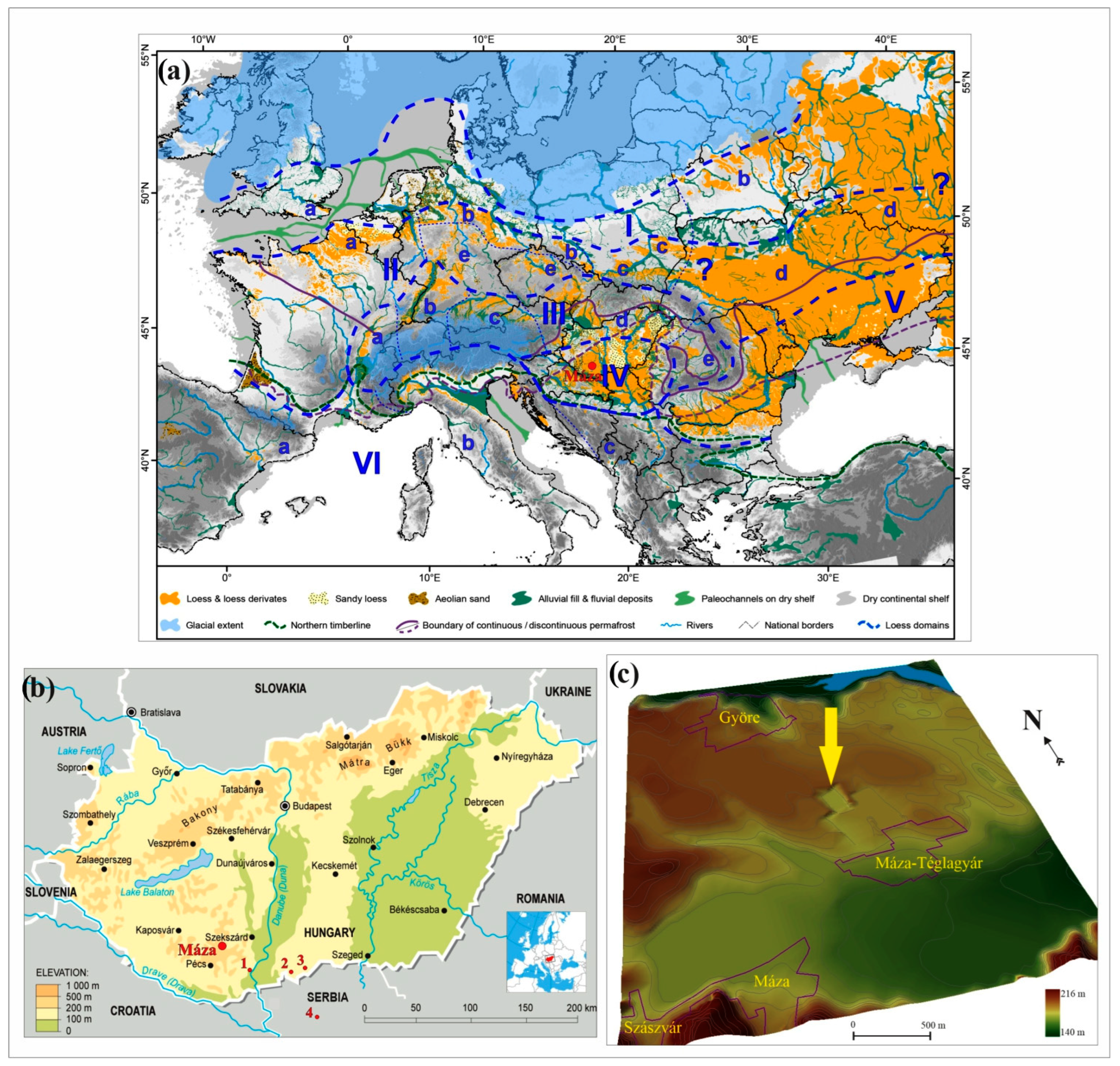



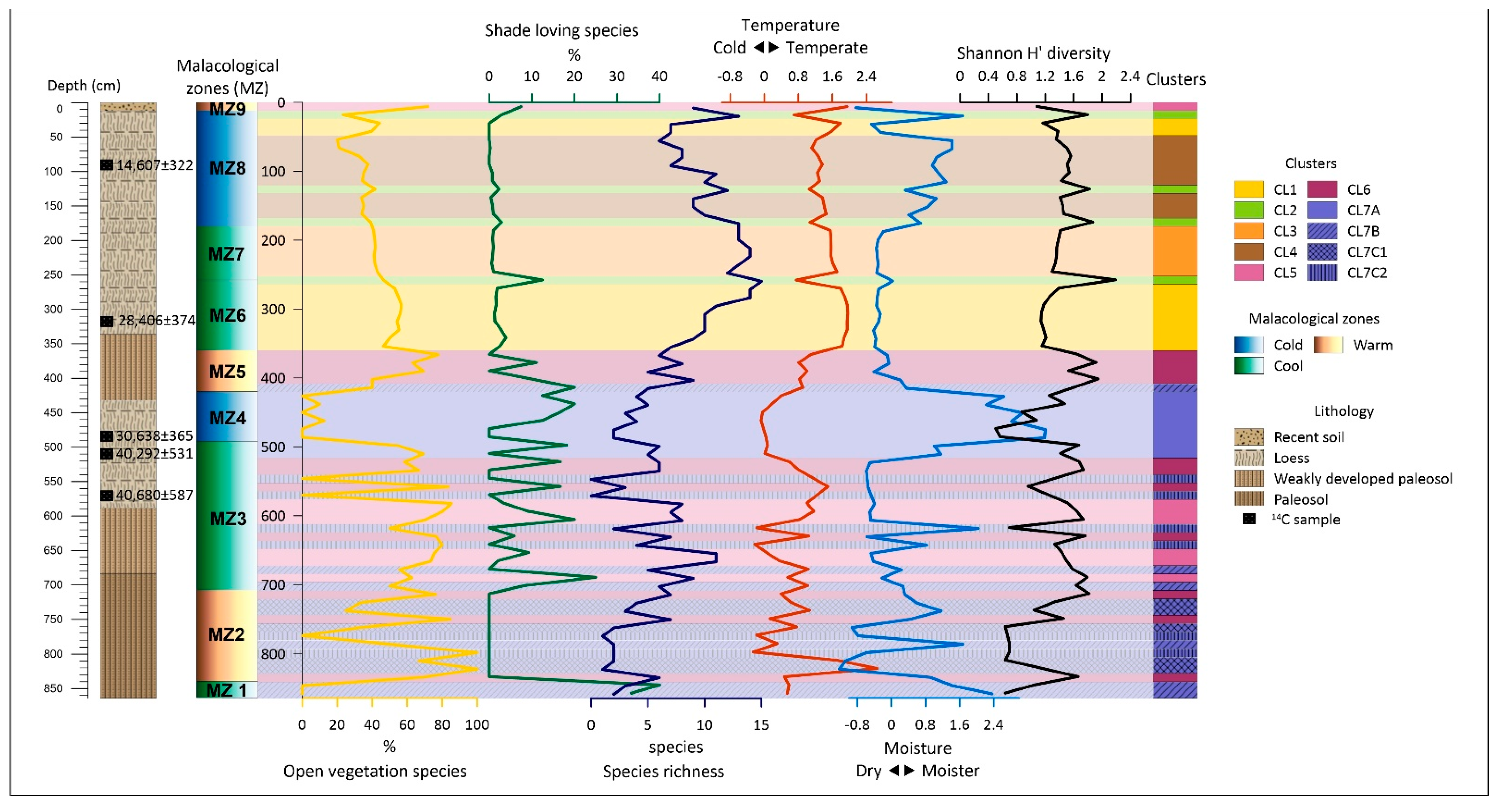
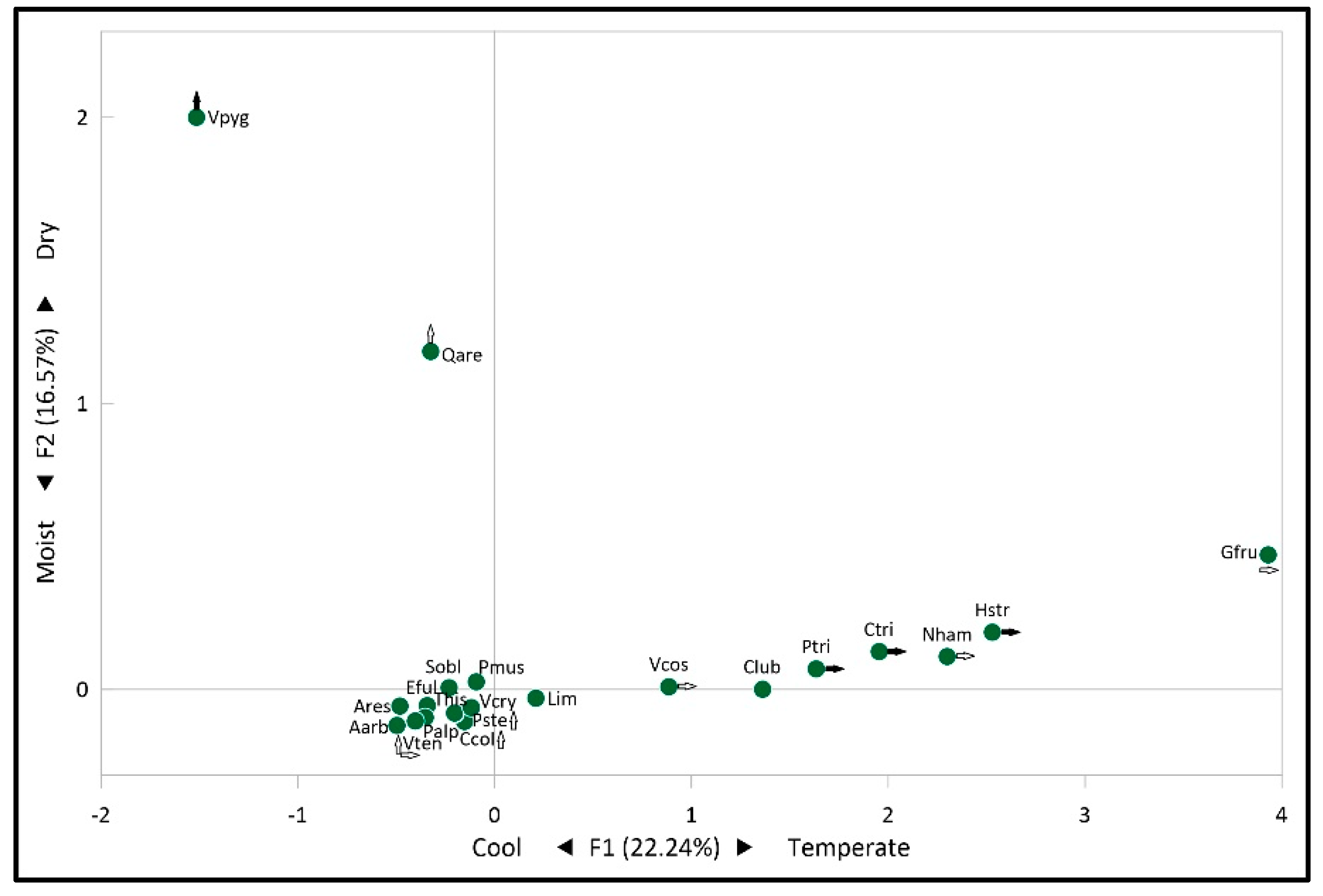
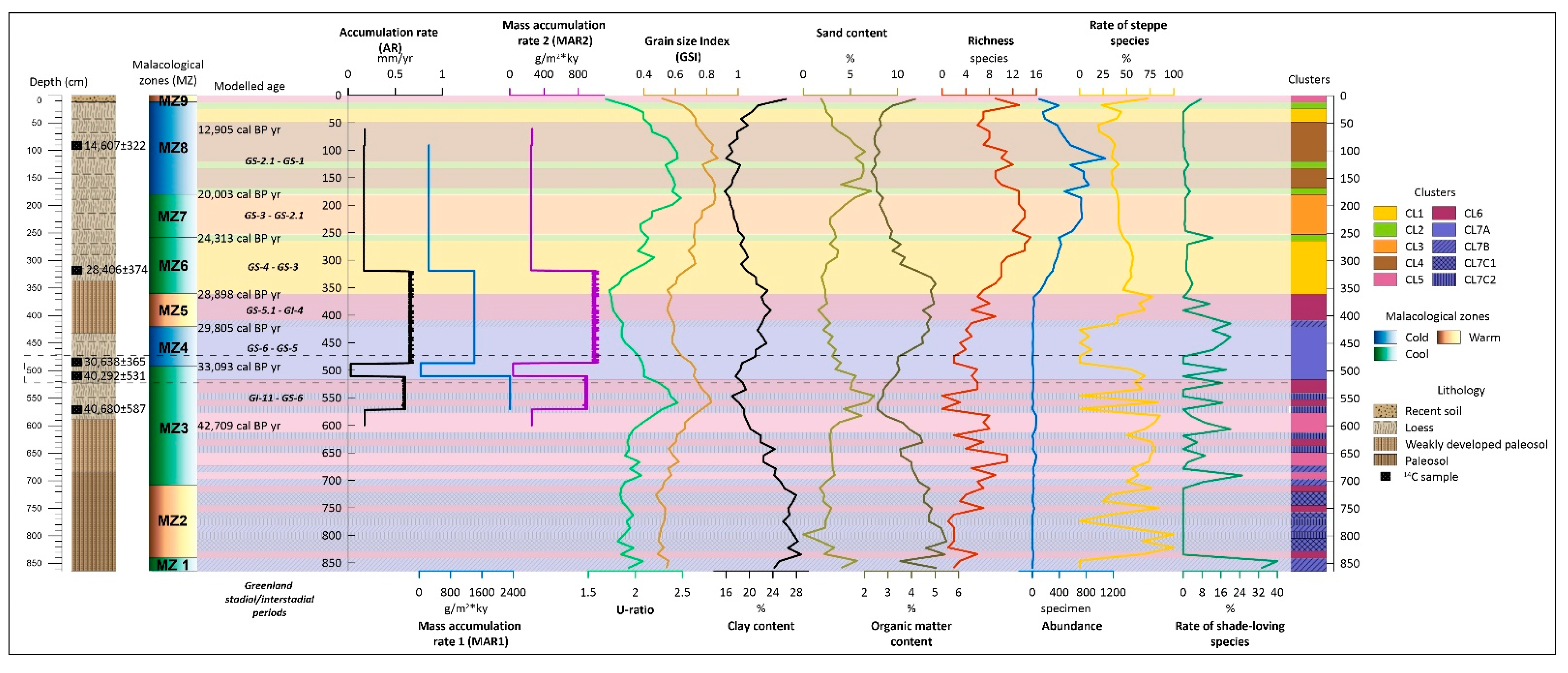
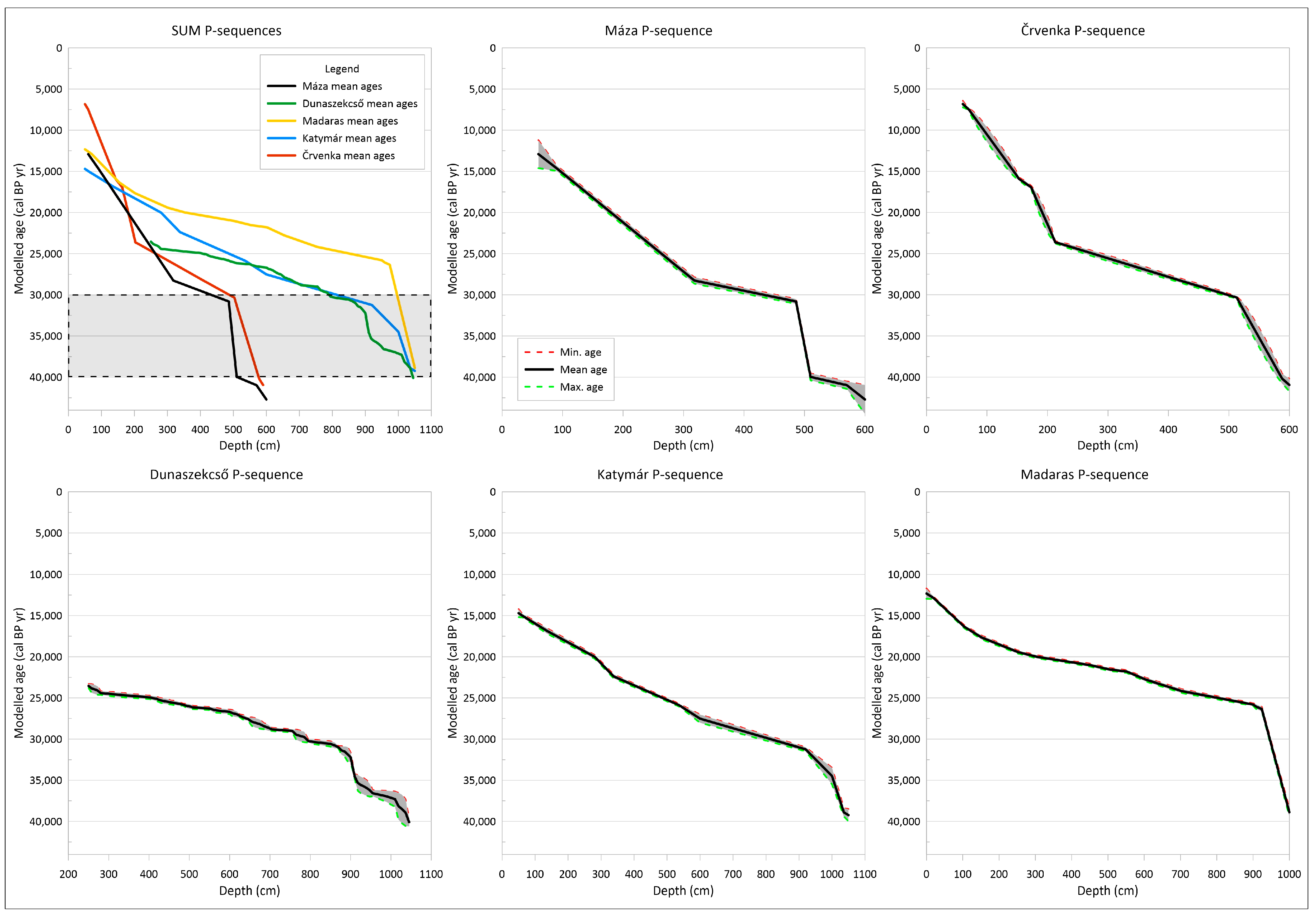
| Depth (cm) | Material | BP yr | +/− | Calibrated Age Range | Mean Age (cal BP yr) | +/− | Lab Code | Probability Distribution | Used for Age Model | |
|---|---|---|---|---|---|---|---|---|---|---|
| Min | Max | |||||||||
| 90 | shell | 12,432 | 49 | 14,285 | 14,930 | 14,607 | 322 | DeA-20934 | 100% | yes |
| 318 | shell | 24,278 | 123 | 28,032 | 28,780 | 28,406 | 374 | DeA-20935 | 100% | yes |
| 414 | shell | 19,361 | 98 | 23,026 | 23,450 | 23,238 | 212 | D-AMS 002121 | 69.3% | no |
| 486 | shell | 26,379 | 148 | 30,273 | 31,003 | 30,638 | 365 | DeA-20936 | 100% | yes |
| 510 | shell | 35,156 | 224 | 39,761 | 40,823 | 40,292 | 531 | D-AMS 002122 | 100% | yes |
| 570 | shell | 35,632 | 292 | 40,093 | 41,267 | 40,680 | 587 | DeA-20937 | 100% | yes |
| MAR (Bulk Density 1) | |||||
|---|---|---|---|---|---|
| Age (cal. BP) | Depth (cm) | SR (cm/Year) | ρ1 (g/cm3) | ƒeol | MAR (g/m2 × ky) |
| 14,607 | 90 | 0.016523 | 1.6 | 1 | 264 |
| 28,406 | 318 | 0.094012 | 1.65 | 1 | 1551 |
| 30,193 | 486 | 0.002376 | 1.65 | 1 | 39 |
| 40,292 | 510 | 0.154639 | 1.65 | 1 | 2552 |
| 40,680 | 570 | - | - | Mean: | 1102 |
| MAR (bulk density 2) | |||||
| Age (cal. BP) | Depth (cm) | SR (cm/Year) | ρ2 (g/cm3) | ƒeol | MAR (g/m2 × ky) |
| 14,607 | 90 | 0.016523 | 1.5 | 1 | 248 |
| 28,406 | 318 | 0.094012 | 1.5 | 1 | 1410 |
| 30,193 | 486 | 0.002376 | 1.5 | 1 | 36 |
| 40,292 | 510 | 0.154639 | 1.5 | 1 | 2320 |
| 40,680 | 570 | - | - | Mean: | 1003 |
| Species | Code | Factor 1 | Factor 2 | Species | Code | Factor 1 | Factor 2 |
|---|---|---|---|---|---|---|---|
| Aegopinella ressmanni | Ares | - | - | Pupilla muscorum | Pmus | 0.057 | - |
| Arianta arbustorum | Aarb | - | - | Pupilla sterri | Pste | 0.138 | 0.018 |
| Chondrula tridens | Ctri | 2.012 | - | Pupilla triplicata | Ptri | 3.459 | - |
| Cochlicopa lubricella | Club | 0.177 | - | Quickella arenaria | Qare | 0.066 | 0.648 |
| Columella columella | Ccol | 0.067 | 0.027 | Succinella oblonga | Sobl | - | - |
| Euconulus fulvus | Eful | 0.079 | - | Trochulus hispidus | This | 0.249 | 0.030 |
| Granaria frumentum | Gfru | 1.168 | - | Vallonia costata | Vcos | 1.337 | - |
| Helicopsis striata | Hstr | 2.399 | - | Vallonia tenuilabris | Vten | 0.473 | 0.026 |
| Limacidae | Llim | 0.078 | - | Vertigo pygmaea | Vpyg | 0.055 | 6.294 |
| Nesovitrea hammonis | Nham | 0.524 | - | Vitrea crystallina | Vcry | - | - |
| Pupilla alpicola | Palp | 0.068 | - | Theoretical threshold: | 0.048 | ||
Disclaimer/Publisher’s Note: The statements, opinions and data contained in all publications are solely those of the individual author(s) and contributor(s) and not of MDPI and/or the editor(s). MDPI and/or the editor(s) disclaim responsibility for any injury to people or property resulting from any ideas, methods, instructions or products referred to in the content. |
© 2024 by the authors. Licensee MDPI, Basel, Switzerland. This article is an open access article distributed under the terms and conditions of the Creative Commons Attribution (CC BY) license (https://creativecommons.org/licenses/by/4.0/).
Share and Cite
Molnár, D.; Makó, L.; Molnár, M.; Sümegi, P. Case Study from Máza Brickyard (SW-Hungary): Paleoecology and Sediment Accumulation Changes in the Southern Part of the Carpathian Basin. Quaternary 2024, 7, 35. https://doi.org/10.3390/quat7030035
Molnár D, Makó L, Molnár M, Sümegi P. Case Study from Máza Brickyard (SW-Hungary): Paleoecology and Sediment Accumulation Changes in the Southern Part of the Carpathian Basin. Quaternary. 2024; 7(3):35. https://doi.org/10.3390/quat7030035
Chicago/Turabian StyleMolnár, Dávid, László Makó, Mihály Molnár, and Pál Sümegi. 2024. "Case Study from Máza Brickyard (SW-Hungary): Paleoecology and Sediment Accumulation Changes in the Southern Part of the Carpathian Basin" Quaternary 7, no. 3: 35. https://doi.org/10.3390/quat7030035
APA StyleMolnár, D., Makó, L., Molnár, M., & Sümegi, P. (2024). Case Study from Máza Brickyard (SW-Hungary): Paleoecology and Sediment Accumulation Changes in the Southern Part of the Carpathian Basin. Quaternary, 7(3), 35. https://doi.org/10.3390/quat7030035







